The Significance of Managing Cultural Diversity: Waitrose Case Study
VerifiedAdded on 2022/11/30
|24
|5082
|136
Project
AI Summary
This research project examines the significance of managing cultural diversity in the workplace, focusing on a case study of the British retail firm Waitrose. The project's introduction highlights the increasing importance of cultural diversity in modern workplaces due to globalization and social progress. The literature review explores the fundamentals of workplace cultural diversity, the advantages gained by firms that manage it effectively, and the practices employed to enhance diversity, as well as the challenges involved. The methodology section outlines the research approach, which is deductive, and the sampling and data analysis methods, including probabilistic sampling and frequency data analysis. The project aims to determine the benefits, practices, and barriers related to creating an equal and diverse workforce within Waitrose and the retail industry. The project uses a cross-sectional time horizon and utilizes a Gantt chart for project management. The conclusion and recommendations, along with a personal reflective statement, provide insights into the research process and potential areas for future study. The project's findings provide valuable insights into the importance of managing cultural diversity in the workplace.

Research Project
Paraphrase This Document
Need a fresh take? Get an instant paraphrase of this document with our AI Paraphraser
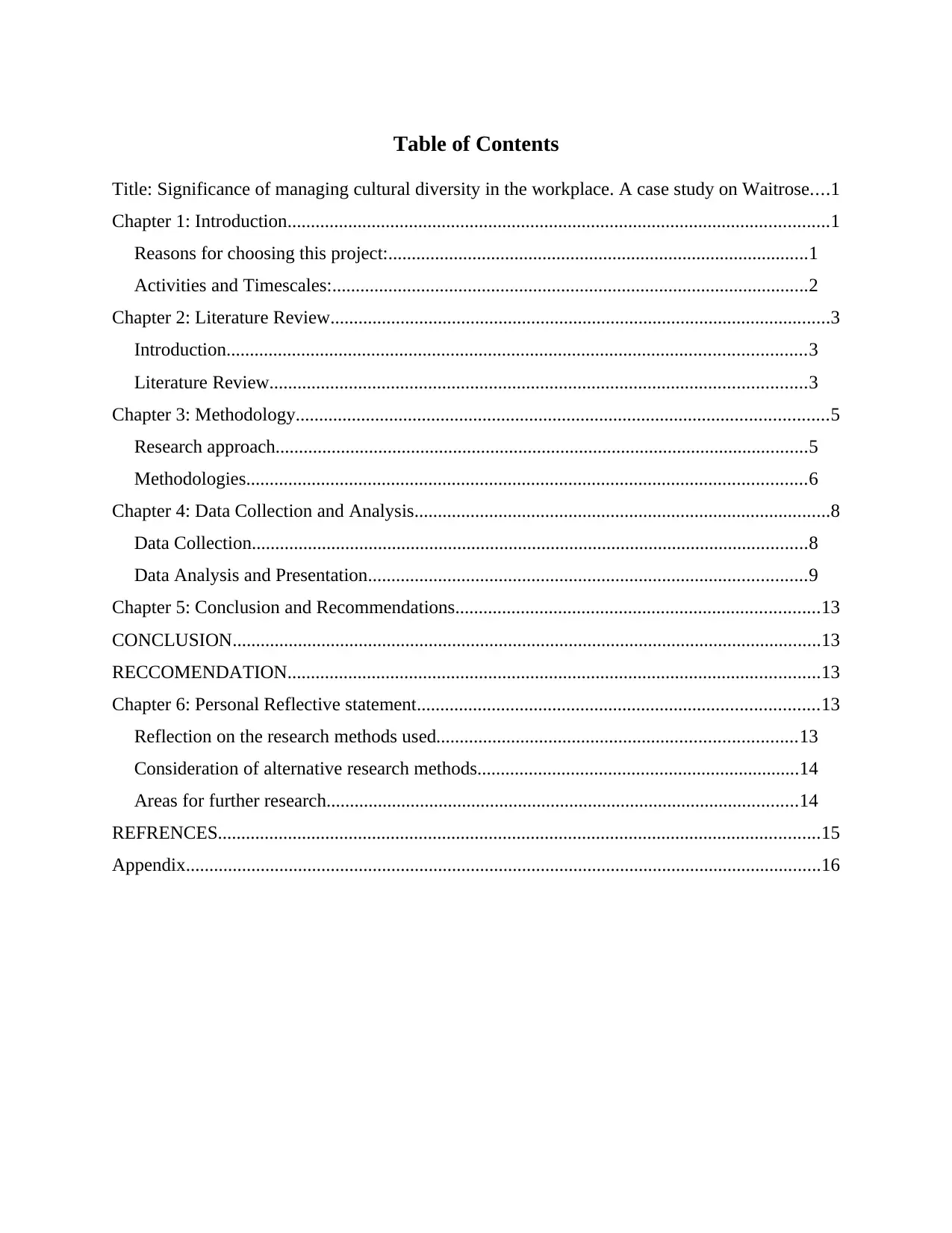
Table of Contents
Title: Significance of managing cultural diversity in the workplace. A case study on Waitrose....1
Chapter 1: Introduction....................................................................................................................1
Reasons for choosing this project:..........................................................................................1
Activities and Timescales:......................................................................................................2
Chapter 2: Literature Review...........................................................................................................3
Introduction............................................................................................................................3
Literature Review...................................................................................................................3
Chapter 3: Methodology..................................................................................................................5
Research approach..................................................................................................................5
Methodologies........................................................................................................................6
Chapter 4: Data Collection and Analysis.........................................................................................8
Data Collection.......................................................................................................................8
Data Analysis and Presentation..............................................................................................9
Chapter 5: Conclusion and Recommendations..............................................................................13
CONCLUSION..............................................................................................................................13
RECCOMENDATION..................................................................................................................13
Chapter 6: Personal Reflective statement......................................................................................13
Reflection on the research methods used.............................................................................13
Consideration of alternative research methods.....................................................................14
Areas for further research.....................................................................................................14
REFRENCES.................................................................................................................................15
Appendix........................................................................................................................................16
Title: Significance of managing cultural diversity in the workplace. A case study on Waitrose....1
Chapter 1: Introduction....................................................................................................................1
Reasons for choosing this project:..........................................................................................1
Activities and Timescales:......................................................................................................2
Chapter 2: Literature Review...........................................................................................................3
Introduction............................................................................................................................3
Literature Review...................................................................................................................3
Chapter 3: Methodology..................................................................................................................5
Research approach..................................................................................................................5
Methodologies........................................................................................................................6
Chapter 4: Data Collection and Analysis.........................................................................................8
Data Collection.......................................................................................................................8
Data Analysis and Presentation..............................................................................................9
Chapter 5: Conclusion and Recommendations..............................................................................13
CONCLUSION..............................................................................................................................13
RECCOMENDATION..................................................................................................................13
Chapter 6: Personal Reflective statement......................................................................................13
Reflection on the research methods used.............................................................................13
Consideration of alternative research methods.....................................................................14
Areas for further research.....................................................................................................14
REFRENCES.................................................................................................................................15
Appendix........................................................................................................................................16
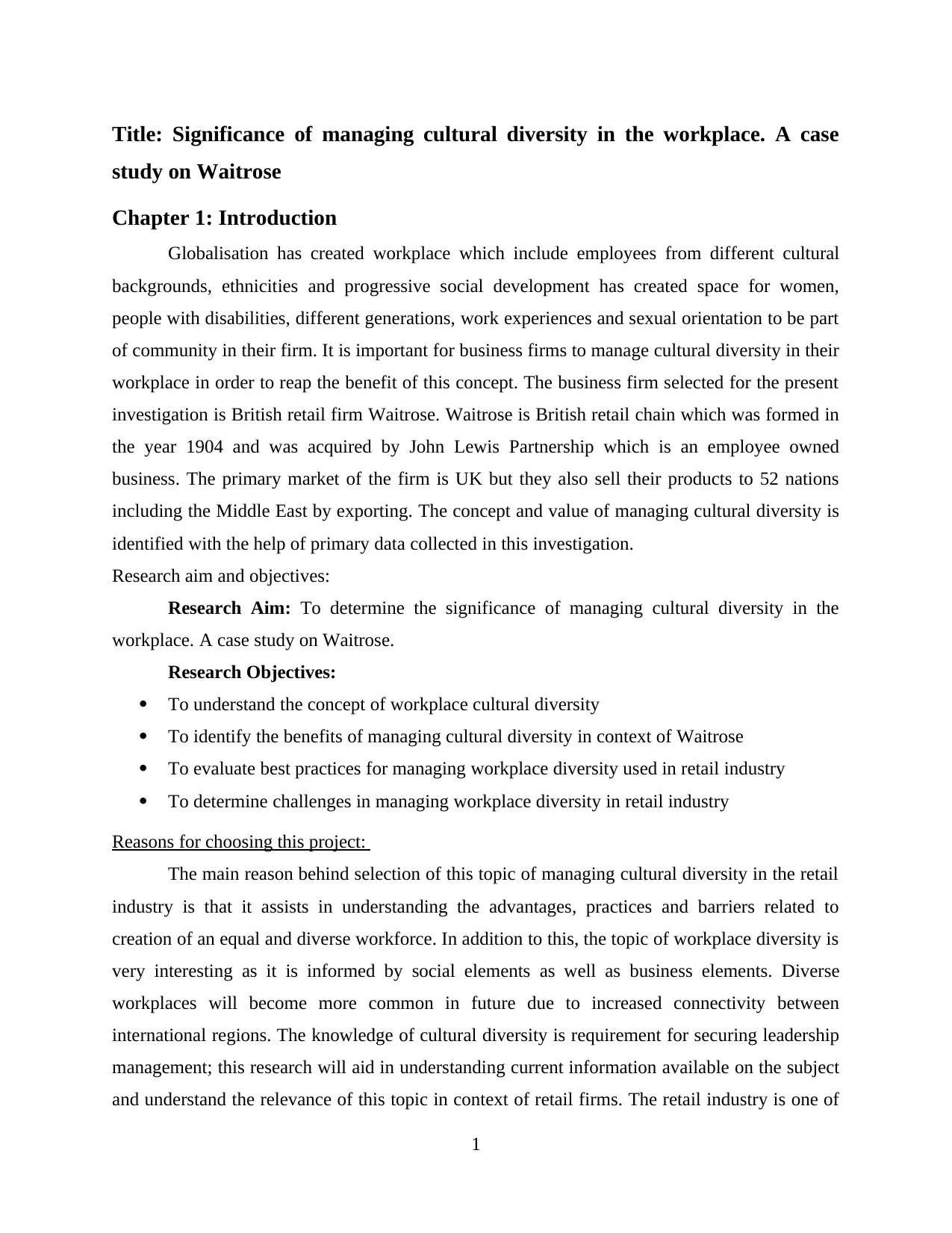
Title: Significance of managing cultural diversity in the workplace. A case
study on Waitrose
Chapter 1: Introduction
Globalisation has created workplace which include employees from different cultural
backgrounds, ethnicities and progressive social development has created space for women,
people with disabilities, different generations, work experiences and sexual orientation to be part
of community in their firm. It is important for business firms to manage cultural diversity in their
workplace in order to reap the benefit of this concept. The business firm selected for the present
investigation is British retail firm Waitrose. Waitrose is British retail chain which was formed in
the year 1904 and was acquired by John Lewis Partnership which is an employee owned
business. The primary market of the firm is UK but they also sell their products to 52 nations
including the Middle East by exporting. The concept and value of managing cultural diversity is
identified with the help of primary data collected in this investigation.
Research aim and objectives:
Research Aim: To determine the significance of managing cultural diversity in the
workplace. A case study on Waitrose.
Research Objectives:
To understand the concept of workplace cultural diversity
To identify the benefits of managing cultural diversity in context of Waitrose
To evaluate best practices for managing workplace diversity used in retail industry
To determine challenges in managing workplace diversity in retail industry
Reasons for choosing this project:
The main reason behind selection of this topic of managing cultural diversity in the retail
industry is that it assists in understanding the advantages, practices and barriers related to
creation of an equal and diverse workforce. In addition to this, the topic of workplace diversity is
very interesting as it is informed by social elements as well as business elements. Diverse
workplaces will become more common in future due to increased connectivity between
international regions. The knowledge of cultural diversity is requirement for securing leadership
management; this research will aid in understanding current information available on the subject
and understand the relevance of this topic in context of retail firms. The retail industry is one of
1
study on Waitrose
Chapter 1: Introduction
Globalisation has created workplace which include employees from different cultural
backgrounds, ethnicities and progressive social development has created space for women,
people with disabilities, different generations, work experiences and sexual orientation to be part
of community in their firm. It is important for business firms to manage cultural diversity in their
workplace in order to reap the benefit of this concept. The business firm selected for the present
investigation is British retail firm Waitrose. Waitrose is British retail chain which was formed in
the year 1904 and was acquired by John Lewis Partnership which is an employee owned
business. The primary market of the firm is UK but they also sell their products to 52 nations
including the Middle East by exporting. The concept and value of managing cultural diversity is
identified with the help of primary data collected in this investigation.
Research aim and objectives:
Research Aim: To determine the significance of managing cultural diversity in the
workplace. A case study on Waitrose.
Research Objectives:
To understand the concept of workplace cultural diversity
To identify the benefits of managing cultural diversity in context of Waitrose
To evaluate best practices for managing workplace diversity used in retail industry
To determine challenges in managing workplace diversity in retail industry
Reasons for choosing this project:
The main reason behind selection of this topic of managing cultural diversity in the retail
industry is that it assists in understanding the advantages, practices and barriers related to
creation of an equal and diverse workforce. In addition to this, the topic of workplace diversity is
very interesting as it is informed by social elements as well as business elements. Diverse
workplaces will become more common in future due to increased connectivity between
international regions. The knowledge of cultural diversity is requirement for securing leadership
management; this research will aid in understanding current information available on the subject
and understand the relevance of this topic in context of retail firms. The retail industry is one of
1
⊘ This is a preview!⊘
Do you want full access?
Subscribe today to unlock all pages.

Trusted by 1+ million students worldwide
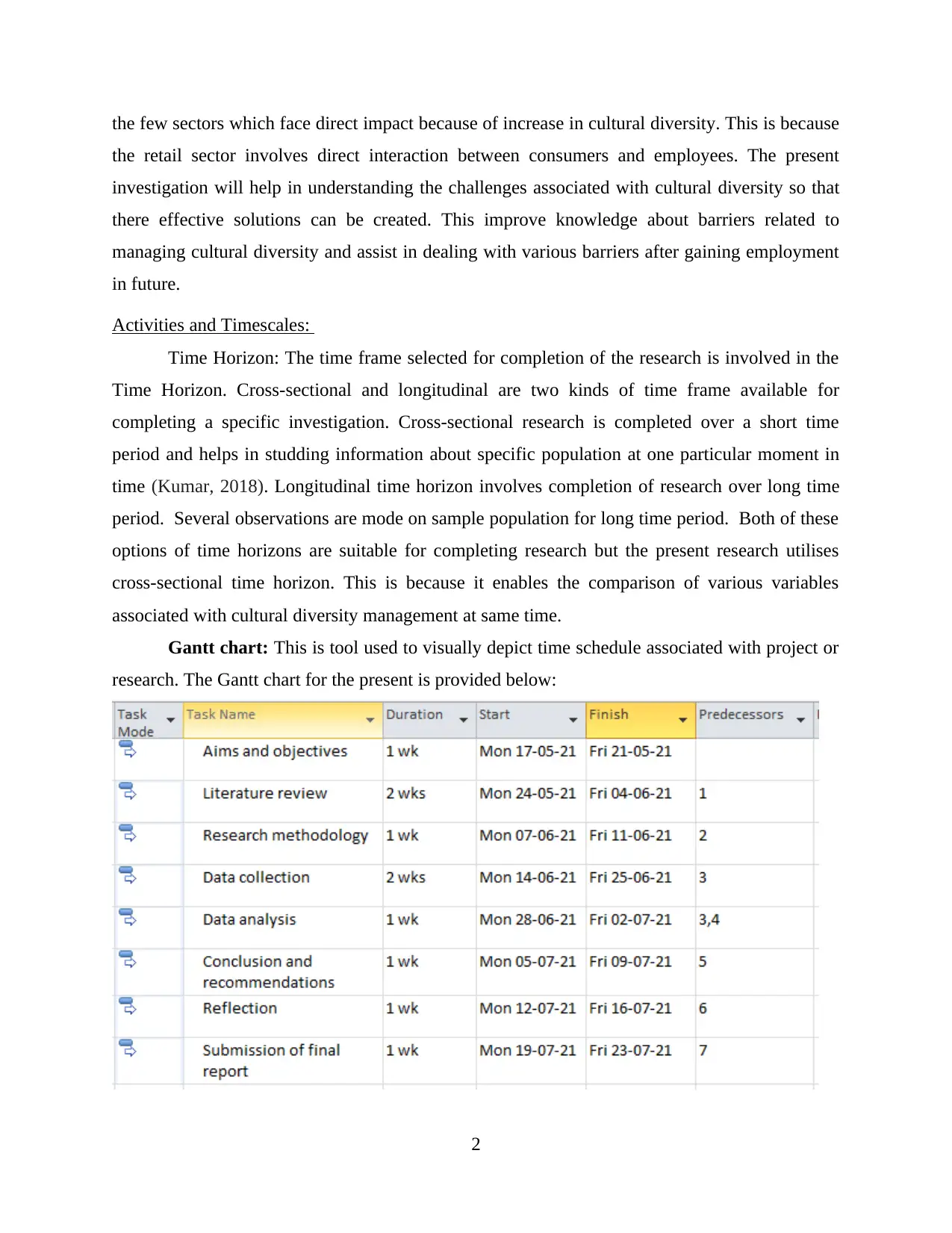
the few sectors which face direct impact because of increase in cultural diversity. This is because
the retail sector involves direct interaction between consumers and employees. The present
investigation will help in understanding the challenges associated with cultural diversity so that
there effective solutions can be created. This improve knowledge about barriers related to
managing cultural diversity and assist in dealing with various barriers after gaining employment
in future.
Activities and Timescales:
Time Horizon: The time frame selected for completion of the research is involved in the
Time Horizon. Cross-sectional and longitudinal are two kinds of time frame available for
completing a specific investigation. Cross-sectional research is completed over a short time
period and helps in studding information about specific population at one particular moment in
time (Kumar, 2018). Longitudinal time horizon involves completion of research over long time
period. Several observations are mode on sample population for long time period. Both of these
options of time horizons are suitable for completing research but the present research utilises
cross-sectional time horizon. This is because it enables the comparison of various variables
associated with cultural diversity management at same time.
Gantt chart: This is tool used to visually depict time schedule associated with project or
research. The Gantt chart for the present is provided below:
2
the retail sector involves direct interaction between consumers and employees. The present
investigation will help in understanding the challenges associated with cultural diversity so that
there effective solutions can be created. This improve knowledge about barriers related to
managing cultural diversity and assist in dealing with various barriers after gaining employment
in future.
Activities and Timescales:
Time Horizon: The time frame selected for completion of the research is involved in the
Time Horizon. Cross-sectional and longitudinal are two kinds of time frame available for
completing a specific investigation. Cross-sectional research is completed over a short time
period and helps in studding information about specific population at one particular moment in
time (Kumar, 2018). Longitudinal time horizon involves completion of research over long time
period. Several observations are mode on sample population for long time period. Both of these
options of time horizons are suitable for completing research but the present research utilises
cross-sectional time horizon. This is because it enables the comparison of various variables
associated with cultural diversity management at same time.
Gantt chart: This is tool used to visually depict time schedule associated with project or
research. The Gantt chart for the present is provided below:
2
Paraphrase This Document
Need a fresh take? Get an instant paraphrase of this document with our AI Paraphraser
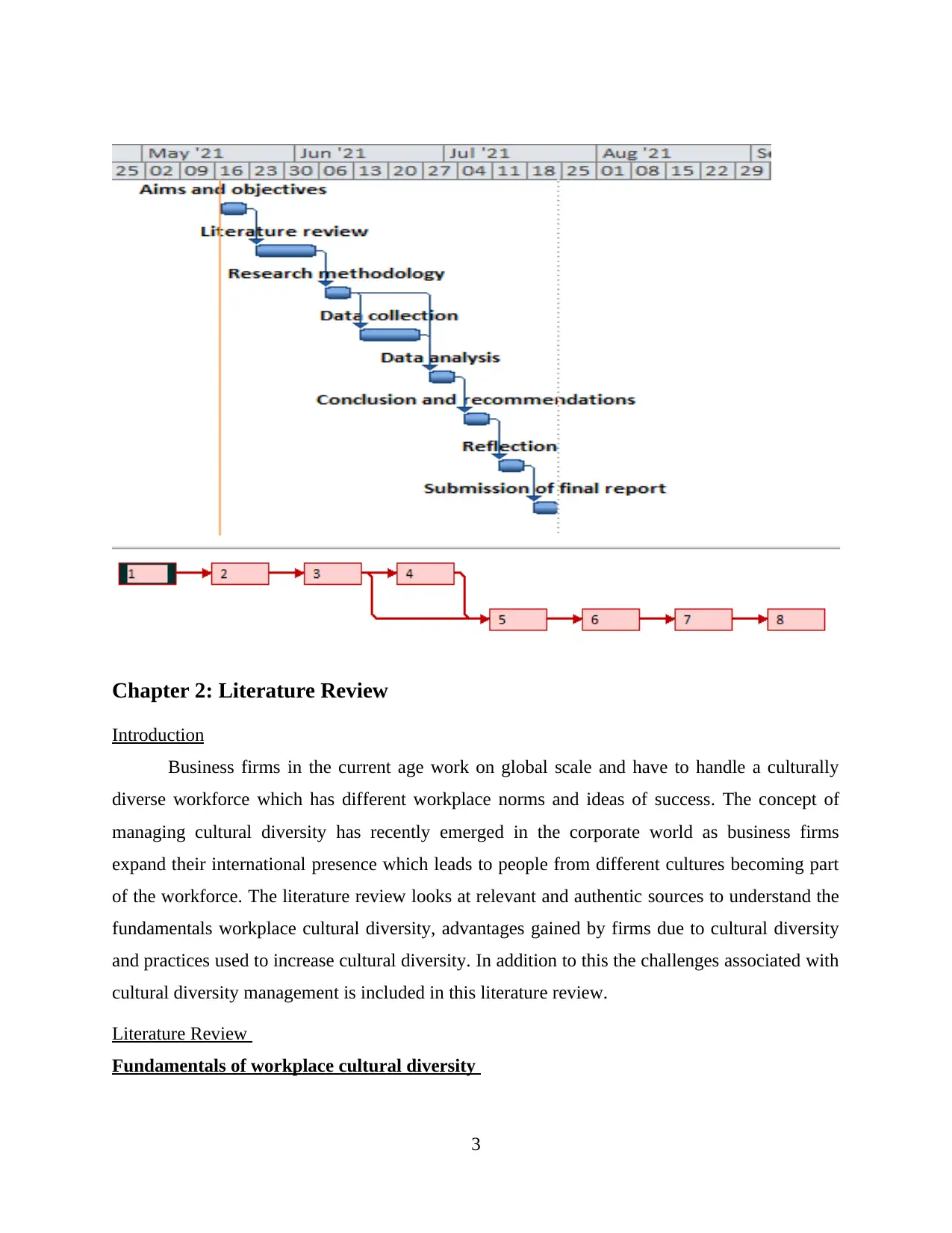
Chapter 2: Literature Review
Introduction
Business firms in the current age work on global scale and have to handle a culturally
diverse workforce which has different workplace norms and ideas of success. The concept of
managing cultural diversity has recently emerged in the corporate world as business firms
expand their international presence which leads to people from different cultures becoming part
of the workforce. The literature review looks at relevant and authentic sources to understand the
fundamentals workplace cultural diversity, advantages gained by firms due to cultural diversity
and practices used to increase cultural diversity. In addition to this the challenges associated with
cultural diversity management is included in this literature review.
Literature Review
Fundamentals of workplace cultural diversity
3
Introduction
Business firms in the current age work on global scale and have to handle a culturally
diverse workforce which has different workplace norms and ideas of success. The concept of
managing cultural diversity has recently emerged in the corporate world as business firms
expand their international presence which leads to people from different cultures becoming part
of the workforce. The literature review looks at relevant and authentic sources to understand the
fundamentals workplace cultural diversity, advantages gained by firms due to cultural diversity
and practices used to increase cultural diversity. In addition to this the challenges associated with
cultural diversity management is included in this literature review.
Literature Review
Fundamentals of workplace cultural diversity
3
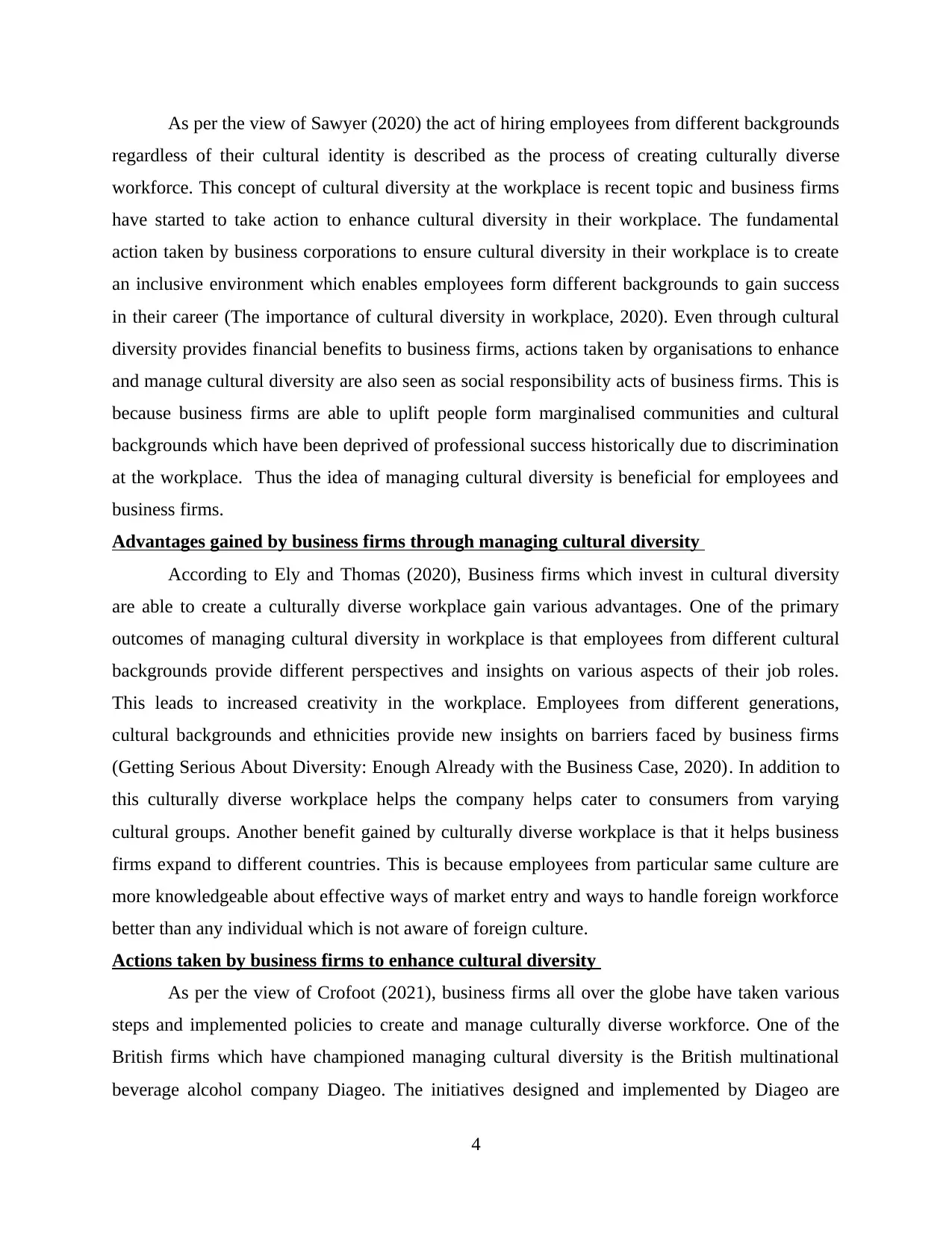
As per the view of Sawyer (2020) the act of hiring employees from different backgrounds
regardless of their cultural identity is described as the process of creating culturally diverse
workforce. This concept of cultural diversity at the workplace is recent topic and business firms
have started to take action to enhance cultural diversity in their workplace. The fundamental
action taken by business corporations to ensure cultural diversity in their workplace is to create
an inclusive environment which enables employees form different backgrounds to gain success
in their career (The importance of cultural diversity in workplace, 2020). Even through cultural
diversity provides financial benefits to business firms, actions taken by organisations to enhance
and manage cultural diversity are also seen as social responsibility acts of business firms. This is
because business firms are able to uplift people form marginalised communities and cultural
backgrounds which have been deprived of professional success historically due to discrimination
at the workplace. Thus the idea of managing cultural diversity is beneficial for employees and
business firms.
Advantages gained by business firms through managing cultural diversity
According to Ely and Thomas (2020), Business firms which invest in cultural diversity
are able to create a culturally diverse workplace gain various advantages. One of the primary
outcomes of managing cultural diversity in workplace is that employees from different cultural
backgrounds provide different perspectives and insights on various aspects of their job roles.
This leads to increased creativity in the workplace. Employees from different generations,
cultural backgrounds and ethnicities provide new insights on barriers faced by business firms
(Getting Serious About Diversity: Enough Already with the Business Case, 2020). In addition to
this culturally diverse workplace helps the company helps cater to consumers from varying
cultural groups. Another benefit gained by culturally diverse workplace is that it helps business
firms expand to different countries. This is because employees from particular same culture are
more knowledgeable about effective ways of market entry and ways to handle foreign workforce
better than any individual which is not aware of foreign culture.
Actions taken by business firms to enhance cultural diversity
As per the view of Crofoot (2021), business firms all over the globe have taken various
steps and implemented policies to create and manage culturally diverse workforce. One of the
British firms which have championed managing cultural diversity is the British multinational
beverage alcohol company Diageo. The initiatives designed and implemented by Diageo are
4
regardless of their cultural identity is described as the process of creating culturally diverse
workforce. This concept of cultural diversity at the workplace is recent topic and business firms
have started to take action to enhance cultural diversity in their workplace. The fundamental
action taken by business corporations to ensure cultural diversity in their workplace is to create
an inclusive environment which enables employees form different backgrounds to gain success
in their career (The importance of cultural diversity in workplace, 2020). Even through cultural
diversity provides financial benefits to business firms, actions taken by organisations to enhance
and manage cultural diversity are also seen as social responsibility acts of business firms. This is
because business firms are able to uplift people form marginalised communities and cultural
backgrounds which have been deprived of professional success historically due to discrimination
at the workplace. Thus the idea of managing cultural diversity is beneficial for employees and
business firms.
Advantages gained by business firms through managing cultural diversity
According to Ely and Thomas (2020), Business firms which invest in cultural diversity
are able to create a culturally diverse workplace gain various advantages. One of the primary
outcomes of managing cultural diversity in workplace is that employees from different cultural
backgrounds provide different perspectives and insights on various aspects of their job roles.
This leads to increased creativity in the workplace. Employees from different generations,
cultural backgrounds and ethnicities provide new insights on barriers faced by business firms
(Getting Serious About Diversity: Enough Already with the Business Case, 2020). In addition to
this culturally diverse workplace helps the company helps cater to consumers from varying
cultural groups. Another benefit gained by culturally diverse workplace is that it helps business
firms expand to different countries. This is because employees from particular same culture are
more knowledgeable about effective ways of market entry and ways to handle foreign workforce
better than any individual which is not aware of foreign culture.
Actions taken by business firms to enhance cultural diversity
As per the view of Crofoot (2021), business firms all over the globe have taken various
steps and implemented policies to create and manage culturally diverse workforce. One of the
British firms which have championed managing cultural diversity is the British multinational
beverage alcohol company Diageo. The initiatives designed and implemented by Diageo are
4
⊘ This is a preview!⊘
Do you want full access?
Subscribe today to unlock all pages.

Trusted by 1+ million students worldwide
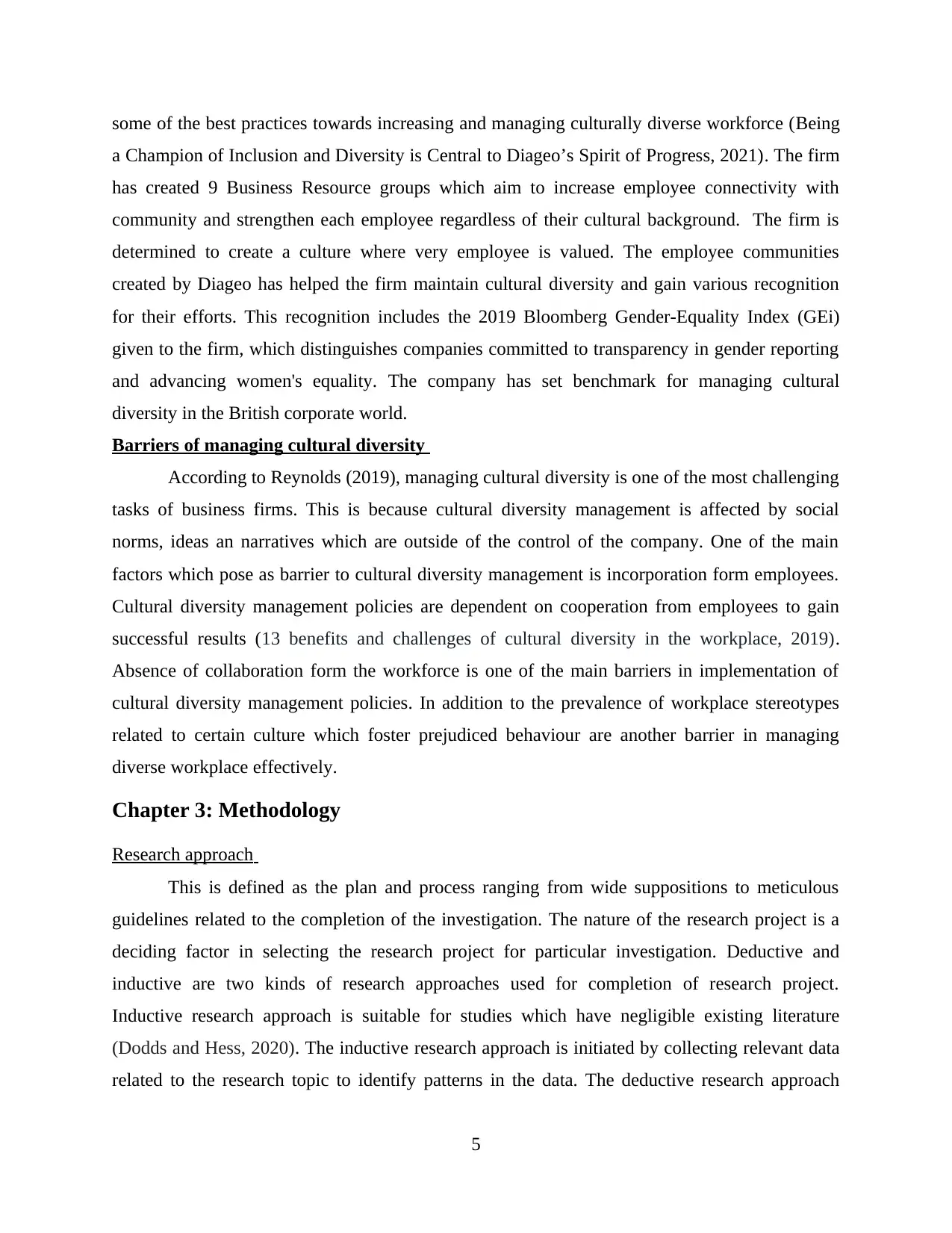
some of the best practices towards increasing and managing culturally diverse workforce (Being
a Champion of Inclusion and Diversity is Central to Diageo’s Spirit of Progress, 2021). The firm
has created 9 Business Resource groups which aim to increase employee connectivity with
community and strengthen each employee regardless of their cultural background. The firm is
determined to create a culture where very employee is valued. The employee communities
created by Diageo has helped the firm maintain cultural diversity and gain various recognition
for their efforts. This recognition includes the 2019 Bloomberg Gender-Equality Index (GEi)
given to the firm, which distinguishes companies committed to transparency in gender reporting
and advancing women's equality. The company has set benchmark for managing cultural
diversity in the British corporate world.
Barriers of managing cultural diversity
According to Reynolds (2019), managing cultural diversity is one of the most challenging
tasks of business firms. This is because cultural diversity management is affected by social
norms, ideas an narratives which are outside of the control of the company. One of the main
factors which pose as barrier to cultural diversity management is incorporation form employees.
Cultural diversity management policies are dependent on cooperation from employees to gain
successful results (13 benefits and challenges of cultural diversity in the workplace, 2019).
Absence of collaboration form the workforce is one of the main barriers in implementation of
cultural diversity management policies. In addition to the prevalence of workplace stereotypes
related to certain culture which foster prejudiced behaviour are another barrier in managing
diverse workplace effectively.
Chapter 3: Methodology
Research approach
This is defined as the plan and process ranging from wide suppositions to meticulous
guidelines related to the completion of the investigation. The nature of the research project is a
deciding factor in selecting the research project for particular investigation. Deductive and
inductive are two kinds of research approaches used for completion of research project.
Inductive research approach is suitable for studies which have negligible existing literature
(Dodds and Hess, 2020). The inductive research approach is initiated by collecting relevant data
related to the research topic to identify patterns in the data. The deductive research approach
5
a Champion of Inclusion and Diversity is Central to Diageo’s Spirit of Progress, 2021). The firm
has created 9 Business Resource groups which aim to increase employee connectivity with
community and strengthen each employee regardless of their cultural background. The firm is
determined to create a culture where very employee is valued. The employee communities
created by Diageo has helped the firm maintain cultural diversity and gain various recognition
for their efforts. This recognition includes the 2019 Bloomberg Gender-Equality Index (GEi)
given to the firm, which distinguishes companies committed to transparency in gender reporting
and advancing women's equality. The company has set benchmark for managing cultural
diversity in the British corporate world.
Barriers of managing cultural diversity
According to Reynolds (2019), managing cultural diversity is one of the most challenging
tasks of business firms. This is because cultural diversity management is affected by social
norms, ideas an narratives which are outside of the control of the company. One of the main
factors which pose as barrier to cultural diversity management is incorporation form employees.
Cultural diversity management policies are dependent on cooperation from employees to gain
successful results (13 benefits and challenges of cultural diversity in the workplace, 2019).
Absence of collaboration form the workforce is one of the main barriers in implementation of
cultural diversity management policies. In addition to the prevalence of workplace stereotypes
related to certain culture which foster prejudiced behaviour are another barrier in managing
diverse workplace effectively.
Chapter 3: Methodology
Research approach
This is defined as the plan and process ranging from wide suppositions to meticulous
guidelines related to the completion of the investigation. The nature of the research project is a
deciding factor in selecting the research project for particular investigation. Deductive and
inductive are two kinds of research approaches used for completion of research project.
Inductive research approach is suitable for studies which have negligible existing literature
(Dodds and Hess, 2020). The inductive research approach is initiated by collecting relevant data
related to the research topic to identify patterns in the data. The deductive research approach
5
Paraphrase This Document
Need a fresh take? Get an instant paraphrase of this document with our AI Paraphraser
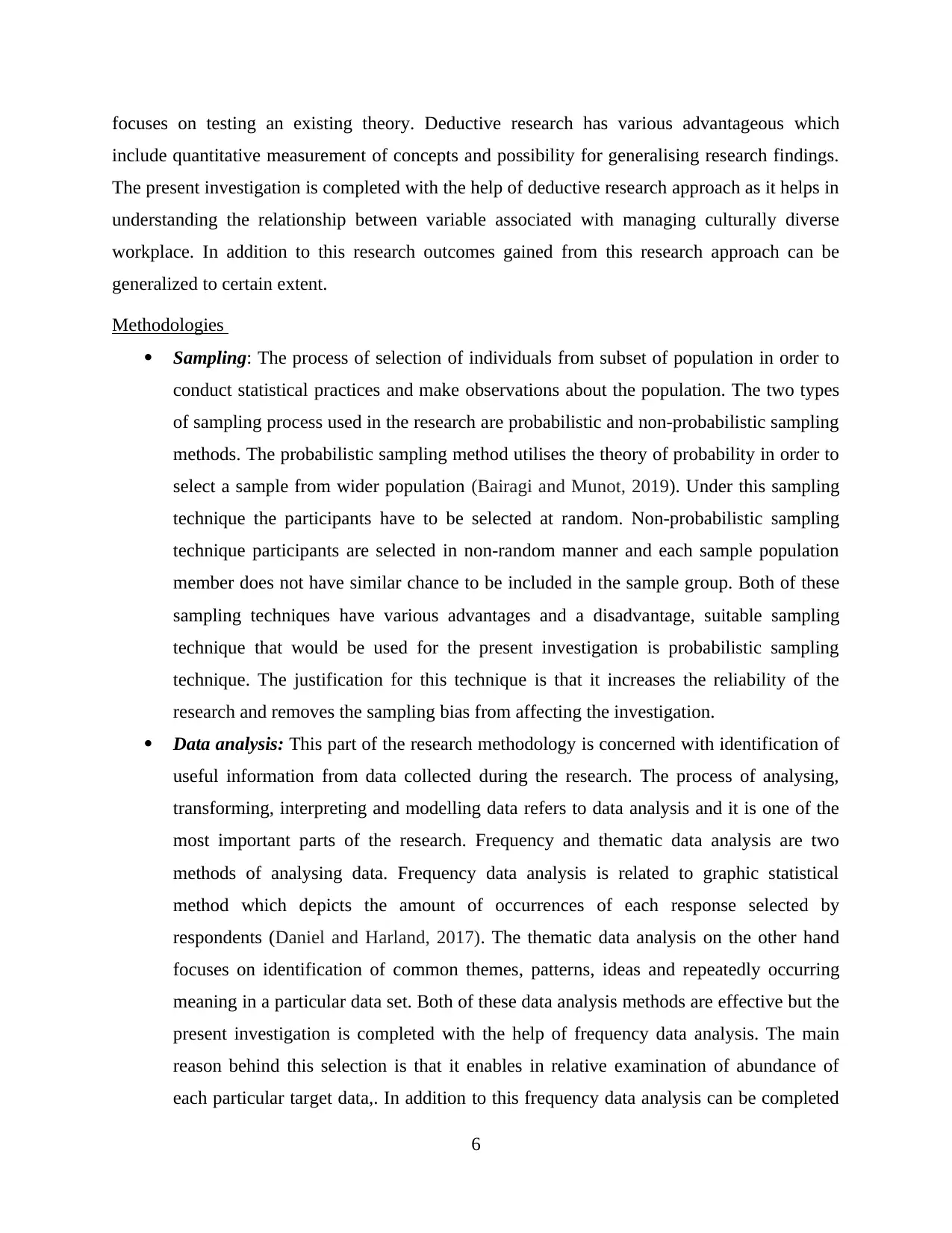
focuses on testing an existing theory. Deductive research has various advantageous which
include quantitative measurement of concepts and possibility for generalising research findings.
The present investigation is completed with the help of deductive research approach as it helps in
understanding the relationship between variable associated with managing culturally diverse
workplace. In addition to this research outcomes gained from this research approach can be
generalized to certain extent.
Methodologies
Sampling: The process of selection of individuals from subset of population in order to
conduct statistical practices and make observations about the population. The two types
of sampling process used in the research are probabilistic and non-probabilistic sampling
methods. The probabilistic sampling method utilises the theory of probability in order to
select a sample from wider population (Bairagi and Munot, 2019). Under this sampling
technique the participants have to be selected at random. Non-probabilistic sampling
technique participants are selected in non-random manner and each sample population
member does not have similar chance to be included in the sample group. Both of these
sampling techniques have various advantages and a disadvantage, suitable sampling
technique that would be used for the present investigation is probabilistic sampling
technique. The justification for this technique is that it increases the reliability of the
research and removes the sampling bias from affecting the investigation.
Data analysis: This part of the research methodology is concerned with identification of
useful information from data collected during the research. The process of analysing,
transforming, interpreting and modelling data refers to data analysis and it is one of the
most important parts of the research. Frequency and thematic data analysis are two
methods of analysing data. Frequency data analysis is related to graphic statistical
method which depicts the amount of occurrences of each response selected by
respondents (Daniel and Harland, 2017). The thematic data analysis on the other hand
focuses on identification of common themes, patterns, ideas and repeatedly occurring
meaning in a particular data set. Both of these data analysis methods are effective but the
present investigation is completed with the help of frequency data analysis. The main
reason behind this selection is that it enables in relative examination of abundance of
each particular target data,. In addition to this frequency data analysis can be completed
6
include quantitative measurement of concepts and possibility for generalising research findings.
The present investigation is completed with the help of deductive research approach as it helps in
understanding the relationship between variable associated with managing culturally diverse
workplace. In addition to this research outcomes gained from this research approach can be
generalized to certain extent.
Methodologies
Sampling: The process of selection of individuals from subset of population in order to
conduct statistical practices and make observations about the population. The two types
of sampling process used in the research are probabilistic and non-probabilistic sampling
methods. The probabilistic sampling method utilises the theory of probability in order to
select a sample from wider population (Bairagi and Munot, 2019). Under this sampling
technique the participants have to be selected at random. Non-probabilistic sampling
technique participants are selected in non-random manner and each sample population
member does not have similar chance to be included in the sample group. Both of these
sampling techniques have various advantages and a disadvantage, suitable sampling
technique that would be used for the present investigation is probabilistic sampling
technique. The justification for this technique is that it increases the reliability of the
research and removes the sampling bias from affecting the investigation.
Data analysis: This part of the research methodology is concerned with identification of
useful information from data collected during the research. The process of analysing,
transforming, interpreting and modelling data refers to data analysis and it is one of the
most important parts of the research. Frequency and thematic data analysis are two
methods of analysing data. Frequency data analysis is related to graphic statistical
method which depicts the amount of occurrences of each response selected by
respondents (Daniel and Harland, 2017). The thematic data analysis on the other hand
focuses on identification of common themes, patterns, ideas and repeatedly occurring
meaning in a particular data set. Both of these data analysis methods are effective but the
present investigation is completed with the help of frequency data analysis. The main
reason behind this selection is that it enables in relative examination of abundance of
each particular target data,. In addition to this frequency data analysis can be completed
6
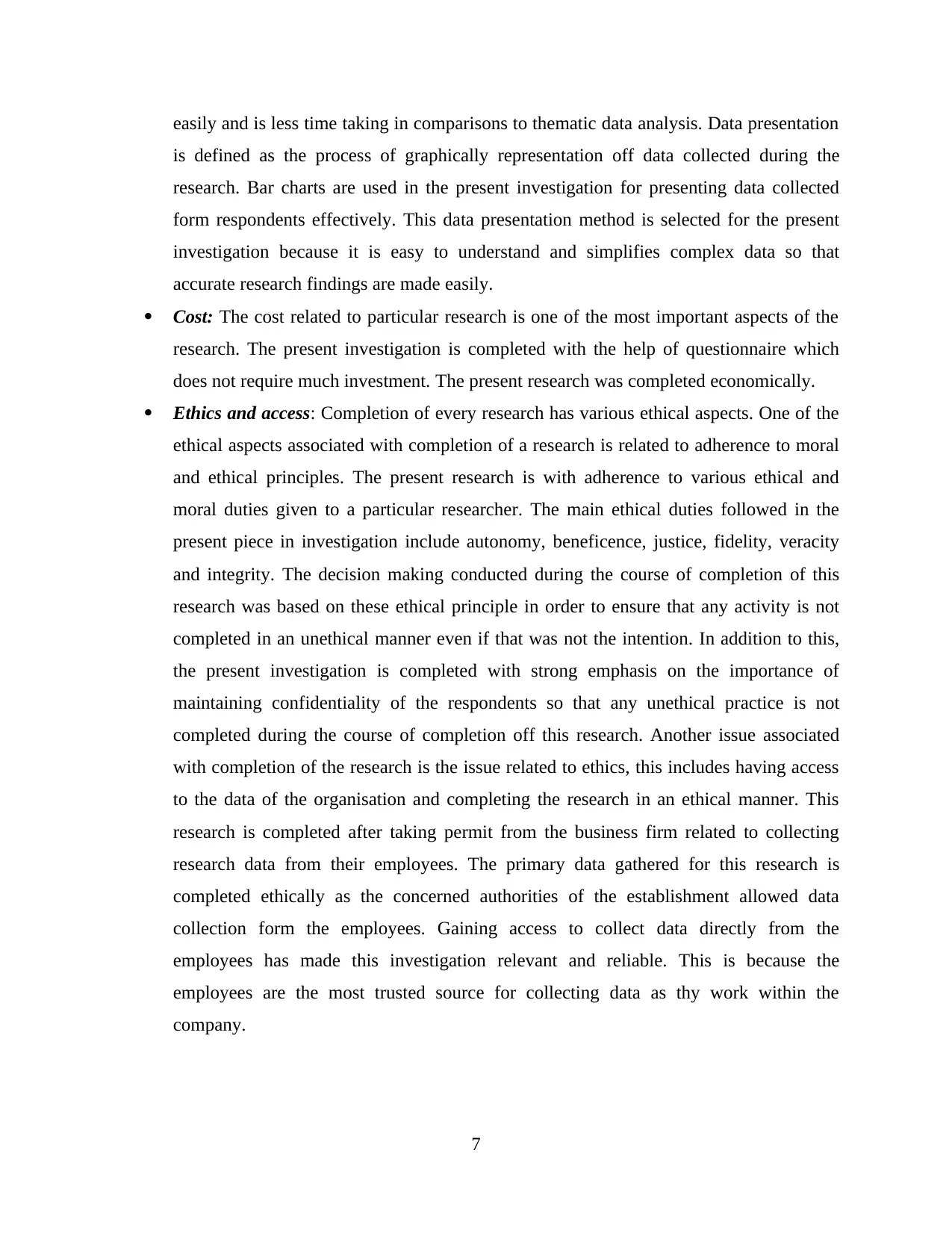
easily and is less time taking in comparisons to thematic data analysis. Data presentation
is defined as the process of graphically representation off data collected during the
research. Bar charts are used in the present investigation for presenting data collected
form respondents effectively. This data presentation method is selected for the present
investigation because it is easy to understand and simplifies complex data so that
accurate research findings are made easily.
Cost: The cost related to particular research is one of the most important aspects of the
research. The present investigation is completed with the help of questionnaire which
does not require much investment. The present research was completed economically.
Ethics and access: Completion of every research has various ethical aspects. One of the
ethical aspects associated with completion of a research is related to adherence to moral
and ethical principles. The present research is with adherence to various ethical and
moral duties given to a particular researcher. The main ethical duties followed in the
present piece in investigation include autonomy, beneficence, justice, fidelity, veracity
and integrity. The decision making conducted during the course of completion of this
research was based on these ethical principle in order to ensure that any activity is not
completed in an unethical manner even if that was not the intention. In addition to this,
the present investigation is completed with strong emphasis on the importance of
maintaining confidentiality of the respondents so that any unethical practice is not
completed during the course of completion off this research. Another issue associated
with completion of the research is the issue related to ethics, this includes having access
to the data of the organisation and completing the research in an ethical manner. This
research is completed after taking permit from the business firm related to collecting
research data from their employees. The primary data gathered for this research is
completed ethically as the concerned authorities of the establishment allowed data
collection form the employees. Gaining access to collect data directly from the
employees has made this investigation relevant and reliable. This is because the
employees are the most trusted source for collecting data as thy work within the
company.
7
is defined as the process of graphically representation off data collected during the
research. Bar charts are used in the present investigation for presenting data collected
form respondents effectively. This data presentation method is selected for the present
investigation because it is easy to understand and simplifies complex data so that
accurate research findings are made easily.
Cost: The cost related to particular research is one of the most important aspects of the
research. The present investigation is completed with the help of questionnaire which
does not require much investment. The present research was completed economically.
Ethics and access: Completion of every research has various ethical aspects. One of the
ethical aspects associated with completion of a research is related to adherence to moral
and ethical principles. The present research is with adherence to various ethical and
moral duties given to a particular researcher. The main ethical duties followed in the
present piece in investigation include autonomy, beneficence, justice, fidelity, veracity
and integrity. The decision making conducted during the course of completion of this
research was based on these ethical principle in order to ensure that any activity is not
completed in an unethical manner even if that was not the intention. In addition to this,
the present investigation is completed with strong emphasis on the importance of
maintaining confidentiality of the respondents so that any unethical practice is not
completed during the course of completion off this research. Another issue associated
with completion of the research is the issue related to ethics, this includes having access
to the data of the organisation and completing the research in an ethical manner. This
research is completed after taking permit from the business firm related to collecting
research data from their employees. The primary data gathered for this research is
completed ethically as the concerned authorities of the establishment allowed data
collection form the employees. Gaining access to collect data directly from the
employees has made this investigation relevant and reliable. This is because the
employees are the most trusted source for collecting data as thy work within the
company.
7
⊘ This is a preview!⊘
Do you want full access?
Subscribe today to unlock all pages.

Trusted by 1+ million students worldwide
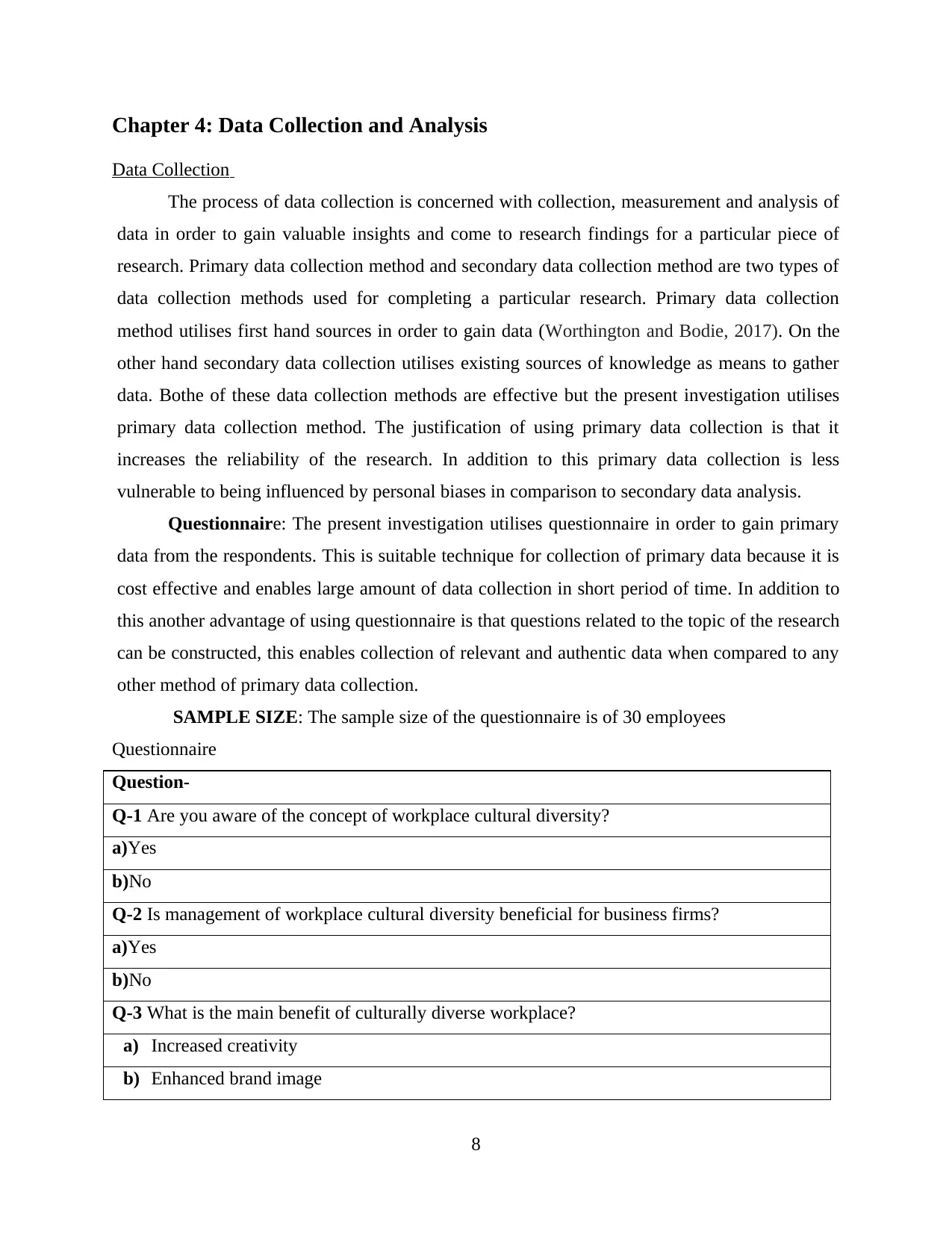
Chapter 4: Data Collection and Analysis
Data Collection
The process of data collection is concerned with collection, measurement and analysis of
data in order to gain valuable insights and come to research findings for a particular piece of
research. Primary data collection method and secondary data collection method are two types of
data collection methods used for completing a particular research. Primary data collection
method utilises first hand sources in order to gain data (Worthington and Bodie, 2017). On the
other hand secondary data collection utilises existing sources of knowledge as means to gather
data. Bothe of these data collection methods are effective but the present investigation utilises
primary data collection method. The justification of using primary data collection is that it
increases the reliability of the research. In addition to this primary data collection is less
vulnerable to being influenced by personal biases in comparison to secondary data analysis.
Questionnaire: The present investigation utilises questionnaire in order to gain primary
data from the respondents. This is suitable technique for collection of primary data because it is
cost effective and enables large amount of data collection in short period of time. In addition to
this another advantage of using questionnaire is that questions related to the topic of the research
can be constructed, this enables collection of relevant and authentic data when compared to any
other method of primary data collection.
SAMPLE SIZE: The sample size of the questionnaire is of 30 employees
Questionnaire
Question-
Q-1 Are you aware of the concept of workplace cultural diversity?
a)Yes
b)No
Q-2 Is management of workplace cultural diversity beneficial for business firms?
a)Yes
b)No
Q-3 What is the main benefit of culturally diverse workplace?
a) Increased creativity
b) Enhanced brand image
8
Data Collection
The process of data collection is concerned with collection, measurement and analysis of
data in order to gain valuable insights and come to research findings for a particular piece of
research. Primary data collection method and secondary data collection method are two types of
data collection methods used for completing a particular research. Primary data collection
method utilises first hand sources in order to gain data (Worthington and Bodie, 2017). On the
other hand secondary data collection utilises existing sources of knowledge as means to gather
data. Bothe of these data collection methods are effective but the present investigation utilises
primary data collection method. The justification of using primary data collection is that it
increases the reliability of the research. In addition to this primary data collection is less
vulnerable to being influenced by personal biases in comparison to secondary data analysis.
Questionnaire: The present investigation utilises questionnaire in order to gain primary
data from the respondents. This is suitable technique for collection of primary data because it is
cost effective and enables large amount of data collection in short period of time. In addition to
this another advantage of using questionnaire is that questions related to the topic of the research
can be constructed, this enables collection of relevant and authentic data when compared to any
other method of primary data collection.
SAMPLE SIZE: The sample size of the questionnaire is of 30 employees
Questionnaire
Question-
Q-1 Are you aware of the concept of workplace cultural diversity?
a)Yes
b)No
Q-2 Is management of workplace cultural diversity beneficial for business firms?
a)Yes
b)No
Q-3 What is the main benefit of culturally diverse workplace?
a) Increased creativity
b) Enhanced brand image
8
Paraphrase This Document
Need a fresh take? Get an instant paraphrase of this document with our AI Paraphraser
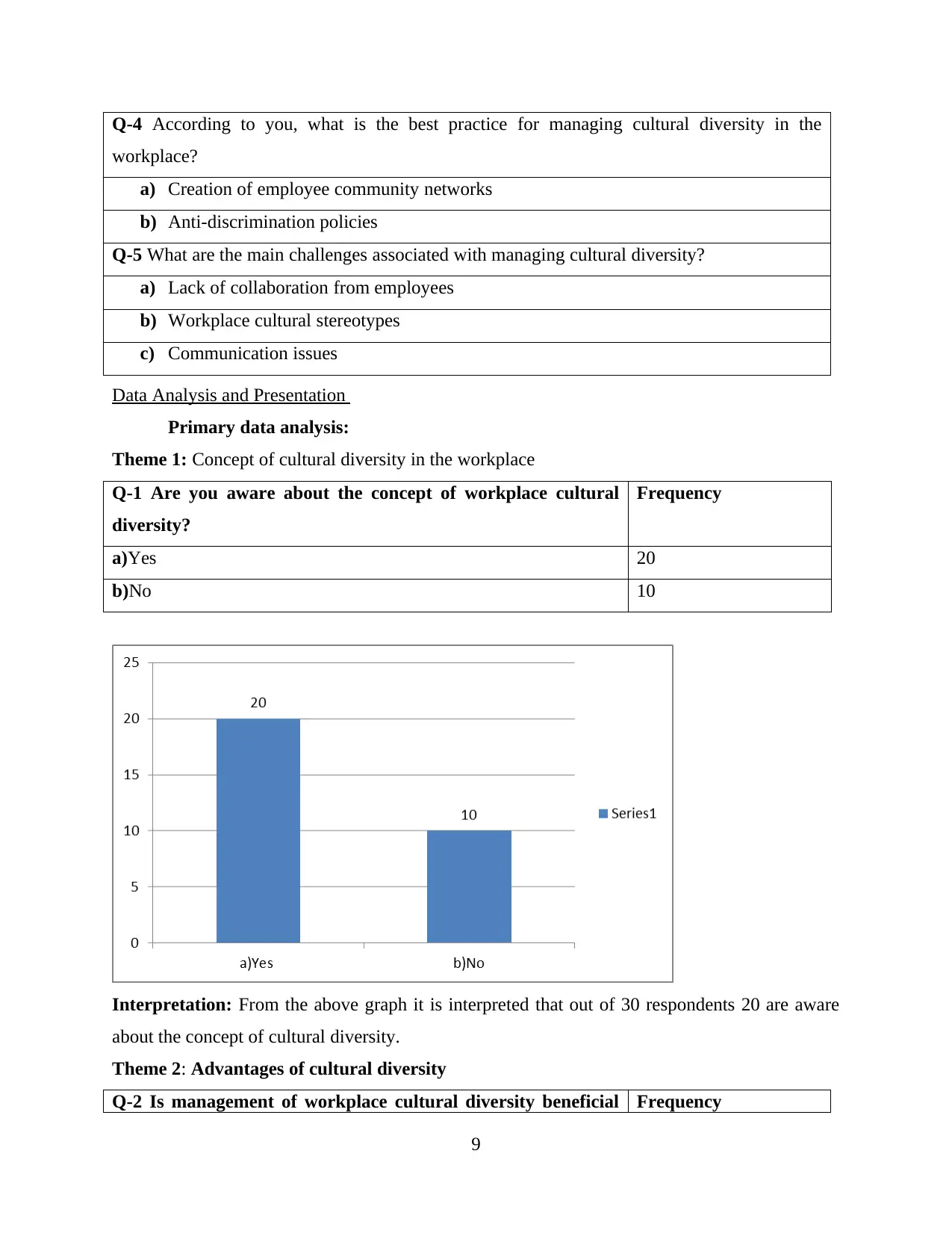
Q-4 According to you, what is the best practice for managing cultural diversity in the
workplace?
a) Creation of employee community networks
b) Anti-discrimination policies
Q-5 What are the main challenges associated with managing cultural diversity?
a) Lack of collaboration from employees
b) Workplace cultural stereotypes
c) Communication issues
Data Analysis and Presentation
Primary data analysis:
Theme 1: Concept of cultural diversity in the workplace
Q-1 Are you aware about the concept of workplace cultural
diversity?
Frequency
a)Yes 20
b)No 10
Interpretation: From the above graph it is interpreted that out of 30 respondents 20 are aware
about the concept of cultural diversity.
Theme 2: Advantages of cultural diversity
Q-2 Is management of workplace cultural diversity beneficial Frequency
9
workplace?
a) Creation of employee community networks
b) Anti-discrimination policies
Q-5 What are the main challenges associated with managing cultural diversity?
a) Lack of collaboration from employees
b) Workplace cultural stereotypes
c) Communication issues
Data Analysis and Presentation
Primary data analysis:
Theme 1: Concept of cultural diversity in the workplace
Q-1 Are you aware about the concept of workplace cultural
diversity?
Frequency
a)Yes 20
b)No 10
Interpretation: From the above graph it is interpreted that out of 30 respondents 20 are aware
about the concept of cultural diversity.
Theme 2: Advantages of cultural diversity
Q-2 Is management of workplace cultural diversity beneficial Frequency
9
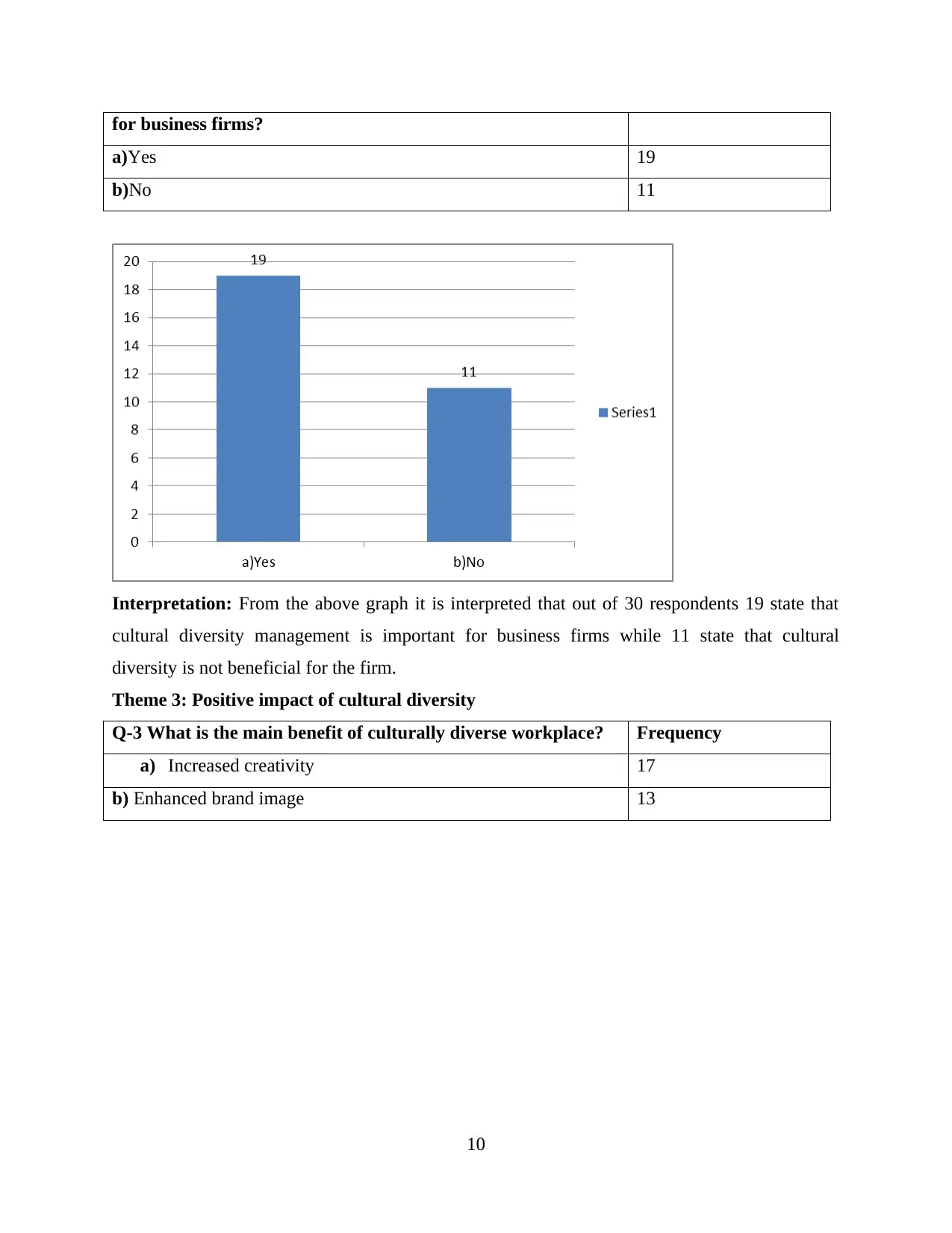
for business firms?
a)Yes 19
b)No 11
Interpretation: From the above graph it is interpreted that out of 30 respondents 19 state that
cultural diversity management is important for business firms while 11 state that cultural
diversity is not beneficial for the firm.
Theme 3: Positive impact of cultural diversity
Q-3 What is the main benefit of culturally diverse workplace? Frequency
a) Increased creativity 17
b) Enhanced brand image 13
10
a)Yes 19
b)No 11
Interpretation: From the above graph it is interpreted that out of 30 respondents 19 state that
cultural diversity management is important for business firms while 11 state that cultural
diversity is not beneficial for the firm.
Theme 3: Positive impact of cultural diversity
Q-3 What is the main benefit of culturally diverse workplace? Frequency
a) Increased creativity 17
b) Enhanced brand image 13
10
⊘ This is a preview!⊘
Do you want full access?
Subscribe today to unlock all pages.

Trusted by 1+ million students worldwide
1 out of 24
Related Documents
Your All-in-One AI-Powered Toolkit for Academic Success.
+13062052269
info@desklib.com
Available 24*7 on WhatsApp / Email
![[object Object]](/_next/static/media/star-bottom.7253800d.svg)
Unlock your academic potential
Copyright © 2020–2025 A2Z Services. All Rights Reserved. Developed and managed by ZUCOL.





